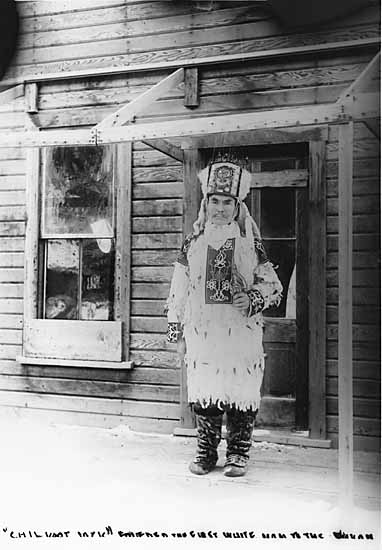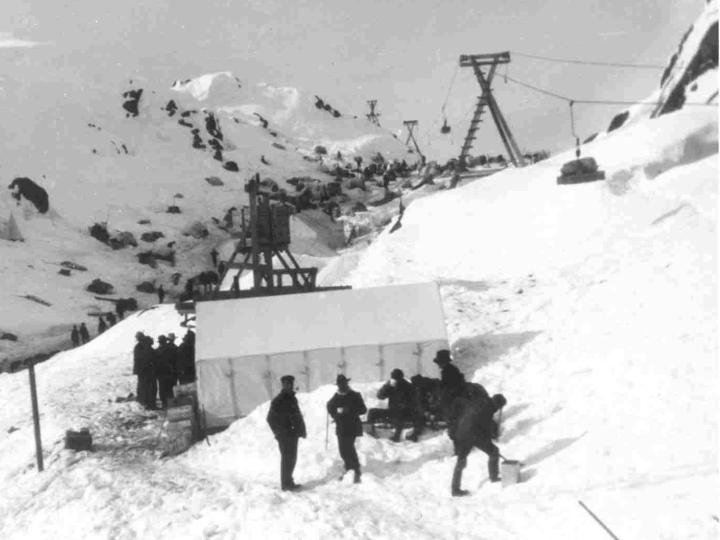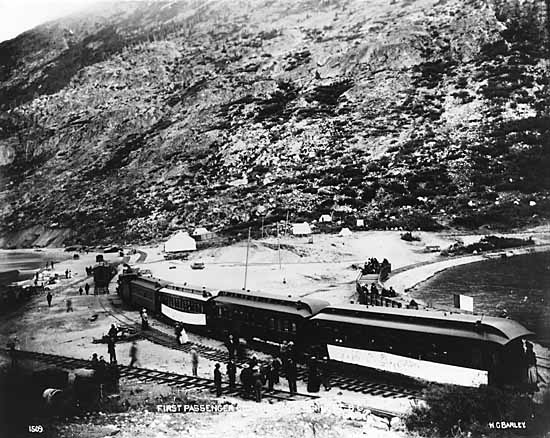
© University of Washington Libraries, Special Collections. La Roche #2035. Detail.
History
Chilkoot Trail National Historic Site
Tlingit trade route

The Chilkoot Trail was one of five trails serving as trade routes into the interior for the coastal Tlingit. Each trail was owned by a specific clan, with the clan leader managing trade over their trail. The Chilkoot Trail was owned by the Raven clan of Chilkoot village.
Each year Tlingit traders would travel into the interior carrying eulachon grease, dried fish and other marine products that they would exchange with interior First Nations for furs, skin clothing and other products from the interior. With the arrival of Russian, British and American fur traders in the mid-19th Century the Tlingit gained easy access to European trade goods. This gave them a new trading advantage over their interior trading partners, while their trails further enabled the Tlingit to establish themselves as middlemen in the lucrative European fur trade.
Prospector's gateway
In 1880 the US Navy negotiated an agreement with the Tlingit to allow prospectors and exploration groups to make limited use of the Chilkoot Trail. Within short order it became established as the primary route by which prospectors made their way into the upper Yukon River basin.
The Tlingit for their part succeeded in using their control of the trail to establish a profitable packing monopoly. This allowed them to capitalize on this new use, while regulating the flow of goods into the interior, to maintain their advantageous trading position.
As the traffic increased, packing became more important than trading itself. Local packers soon found it difficult to meet the demand, placing strains on the traditional system of Tlingit land rights. As the packing business expanded it came to include non-local Tlingit and interior Tagish packers.
Poor man's route to the Klondike

In the summer of 1897, news of the Klondike gold strike turned the intermittent trickle of hardy prospectors making their way over the trail each spring, into an uncontrollable flood of hapless fortune seekers struggling over the trail through the dead of winter.
Although numerous routes to the gold fields were available, the Chilkoot Trail provided the shortest and cheapest route to the Klondike. Consequently, it attracted the majority of the gold seekers. Known as the poor man's route to the Klondike, it permitted an individual to transport their supplies over the trail by their own labour.
Hauling large volumes of food, equipment and other goods, an unbroken line of stampeders moved forward slowly and hesitantly, consuming the limited forests along the trail, gradually churning the trail into quagmire. The men, women and children making the journey over the pass, were a cross section of North American society. Offices, stores and farms were forsaken for the chance to pan the golden gravels of the Klondike. Inexperienced, disorganized and unfamiliar with all aspects of wilderness living, the individuals on the trail found themselves part of a great stampede of people heading northward.
Free enterprise

Tlingit and Tagish packers initially cashed in on the flood, but the sheer volume of traffic, competition from other packers and technical improvements to the trail soon ended their monopoly. From a simple horse-powered windlass pulling sleighs up the steep final ascent to the Pass, transportation developments culminated in an intricate network of aerial freight tramways capable of carrying nine tons of material every hour from Sheep Camp over the pass. From the aerial terminal at Crater Lake, a system of ferries, sleds and wagons was operated to haul goods to either Lindeman City or Lake Bennett where people built boats for the trip down the Yukon River to Dawson City.
Bypassed by the WP & YR

In the summer of 1899 the White Pass & Yukon Route (WP&YR) railway arrived at Lake Bennett. Almost immediately the Chilkoot Trail was abandoned in favour of this newer, faster and cheaper way of moving goods and people into the interior. Initially the tramways tried to compete, but in short order were bought out by the WP&YR and dismantled.
For a brief time the town of Bennett, at the end of the steel, boomed. But on July 29, 1900 when the “golden spike” was driven in Carcross, completing the rail line to Whitehorse, its importance soon faded. Though the Chilkoot Trail fell into disuse, its role as the primary route by which people made their way to the Klondike during the great gold rush of 1896-99 secured its place in the annals of legend.
Related links
- Date modified :